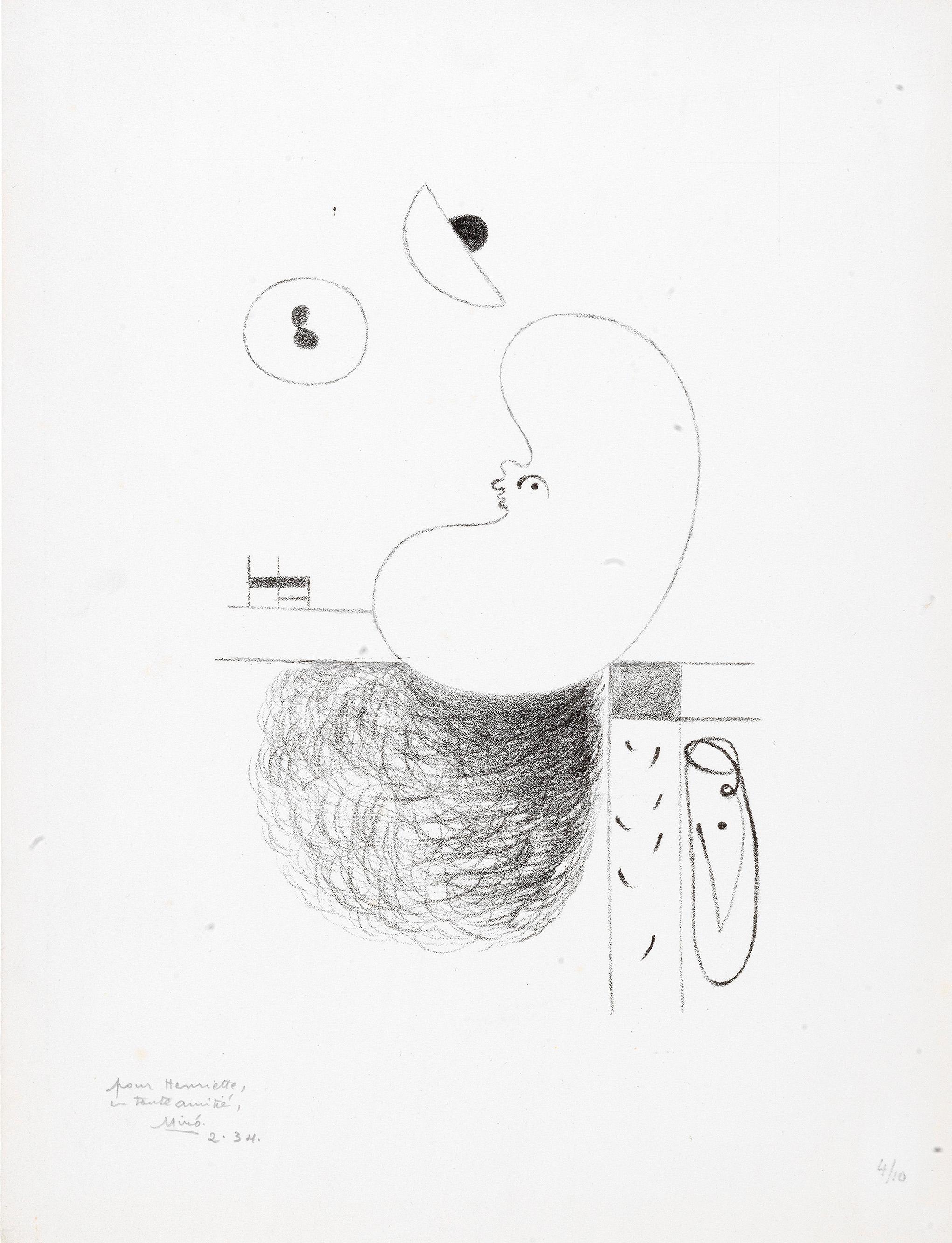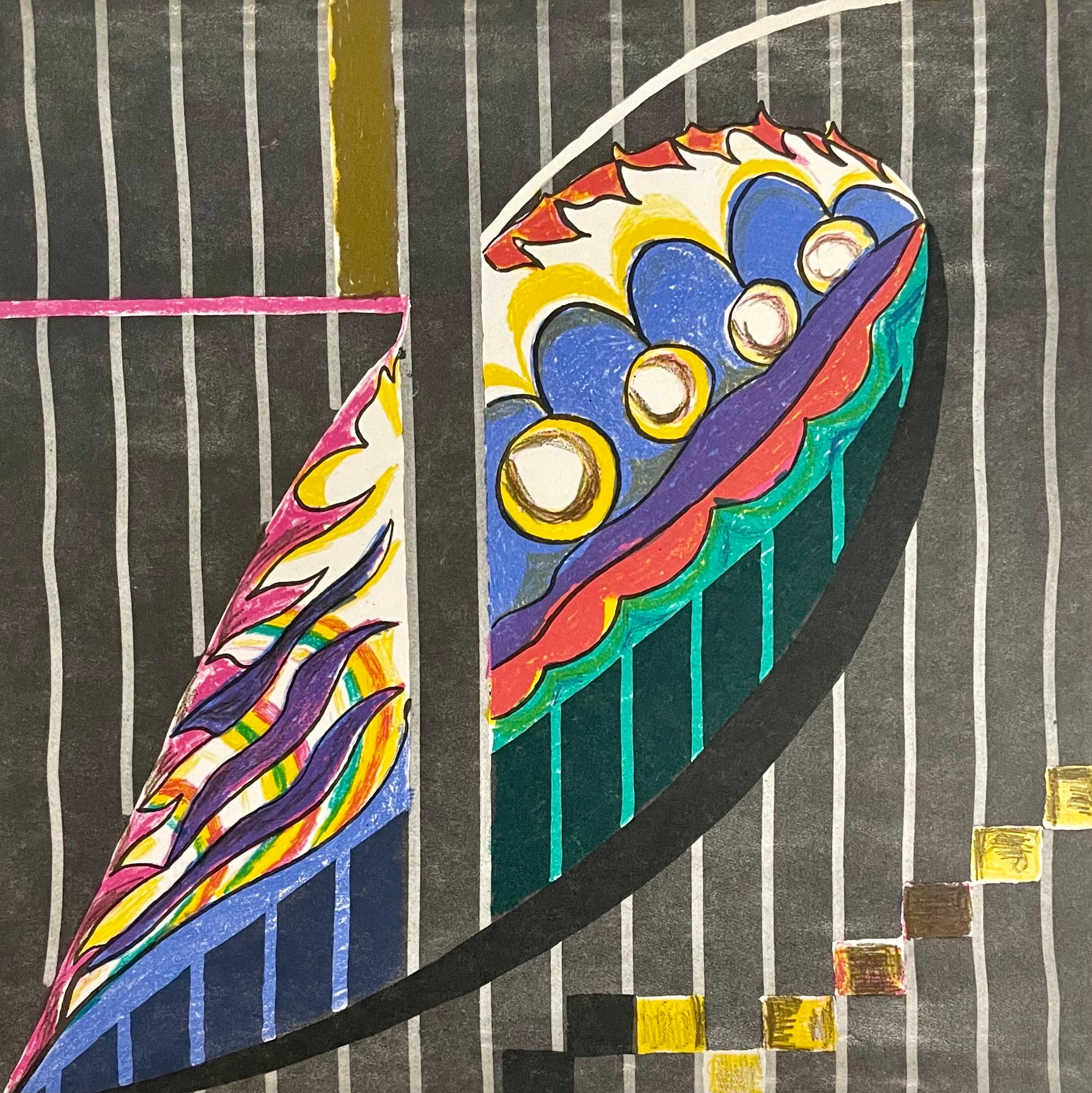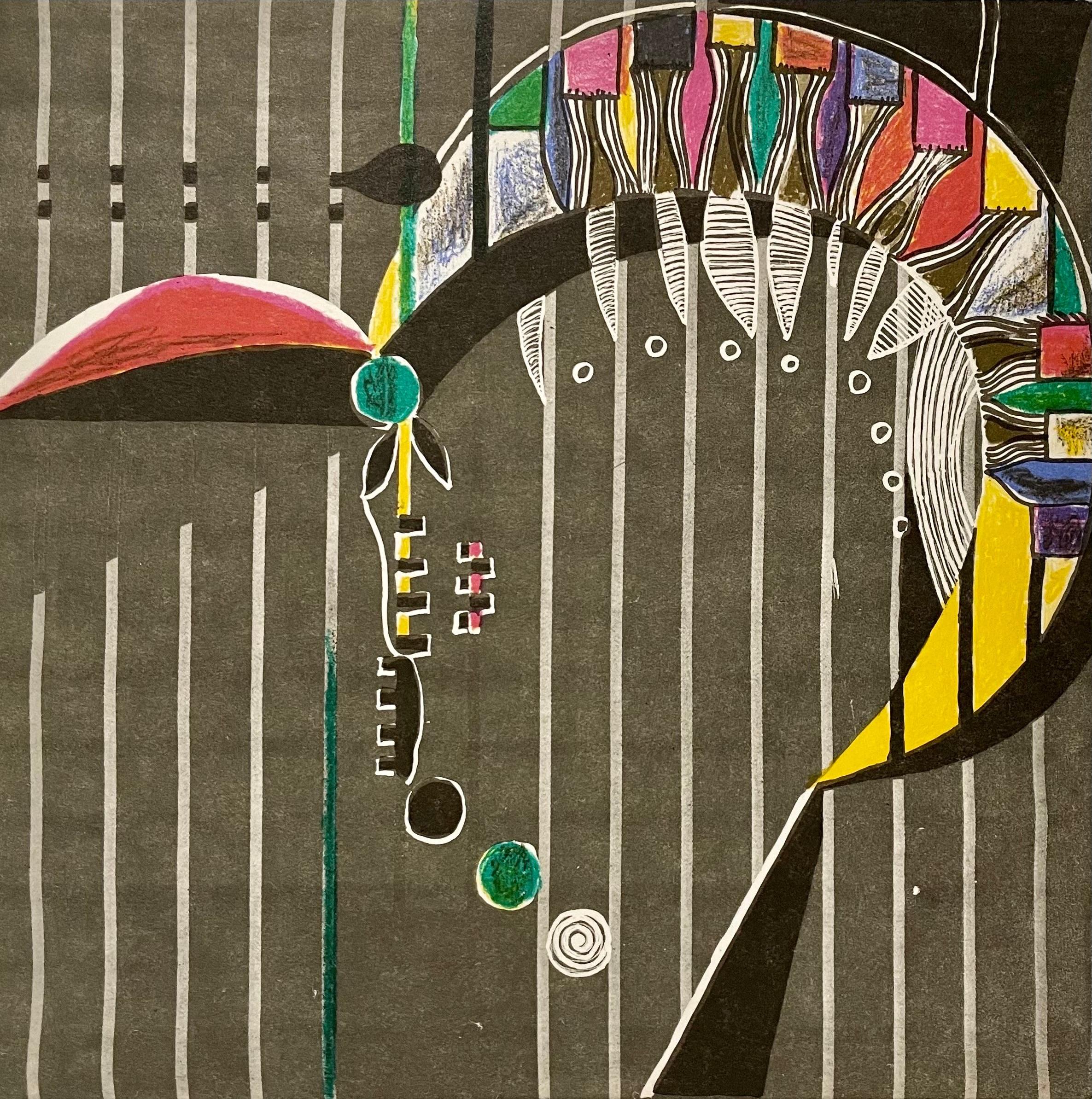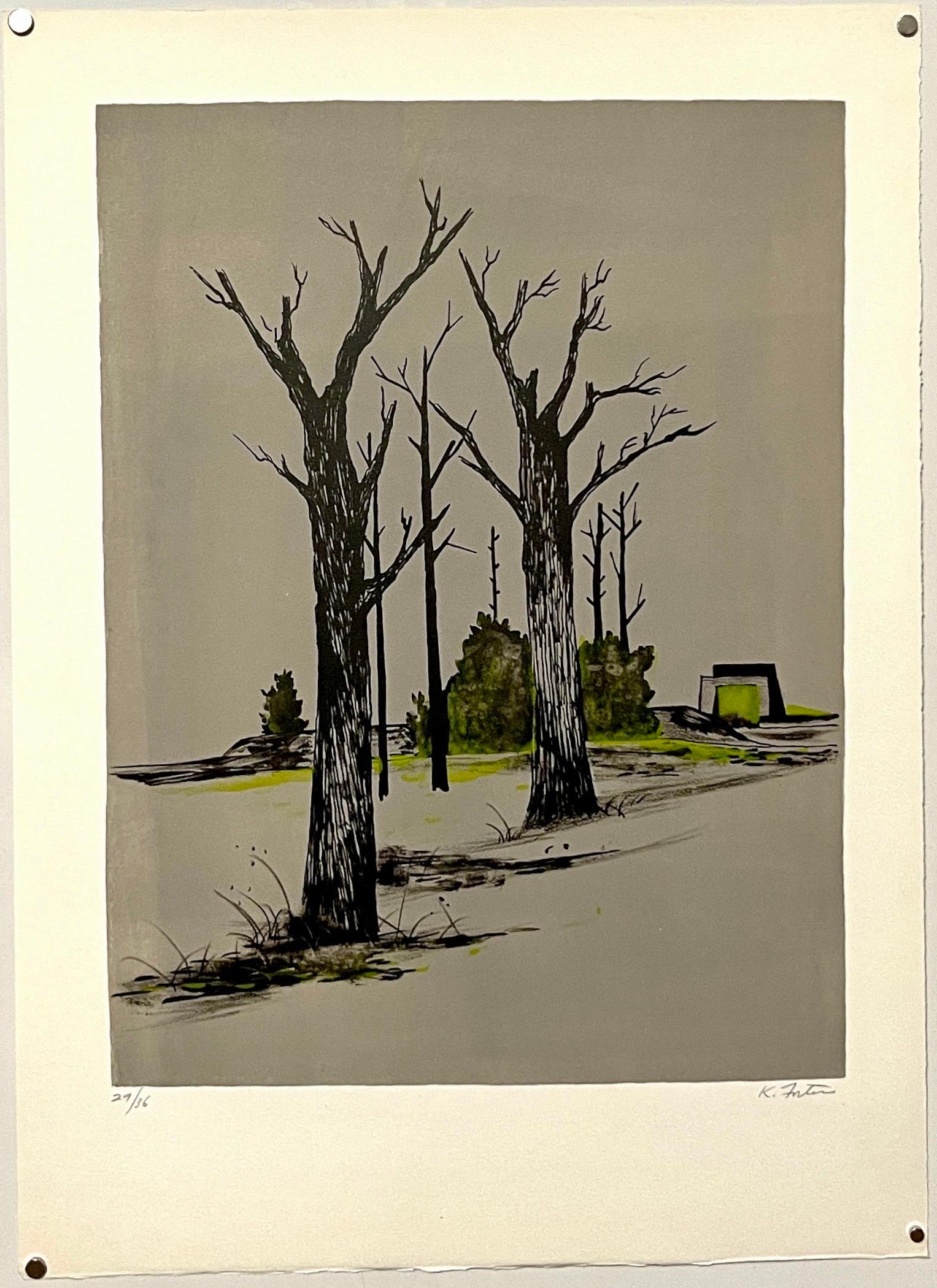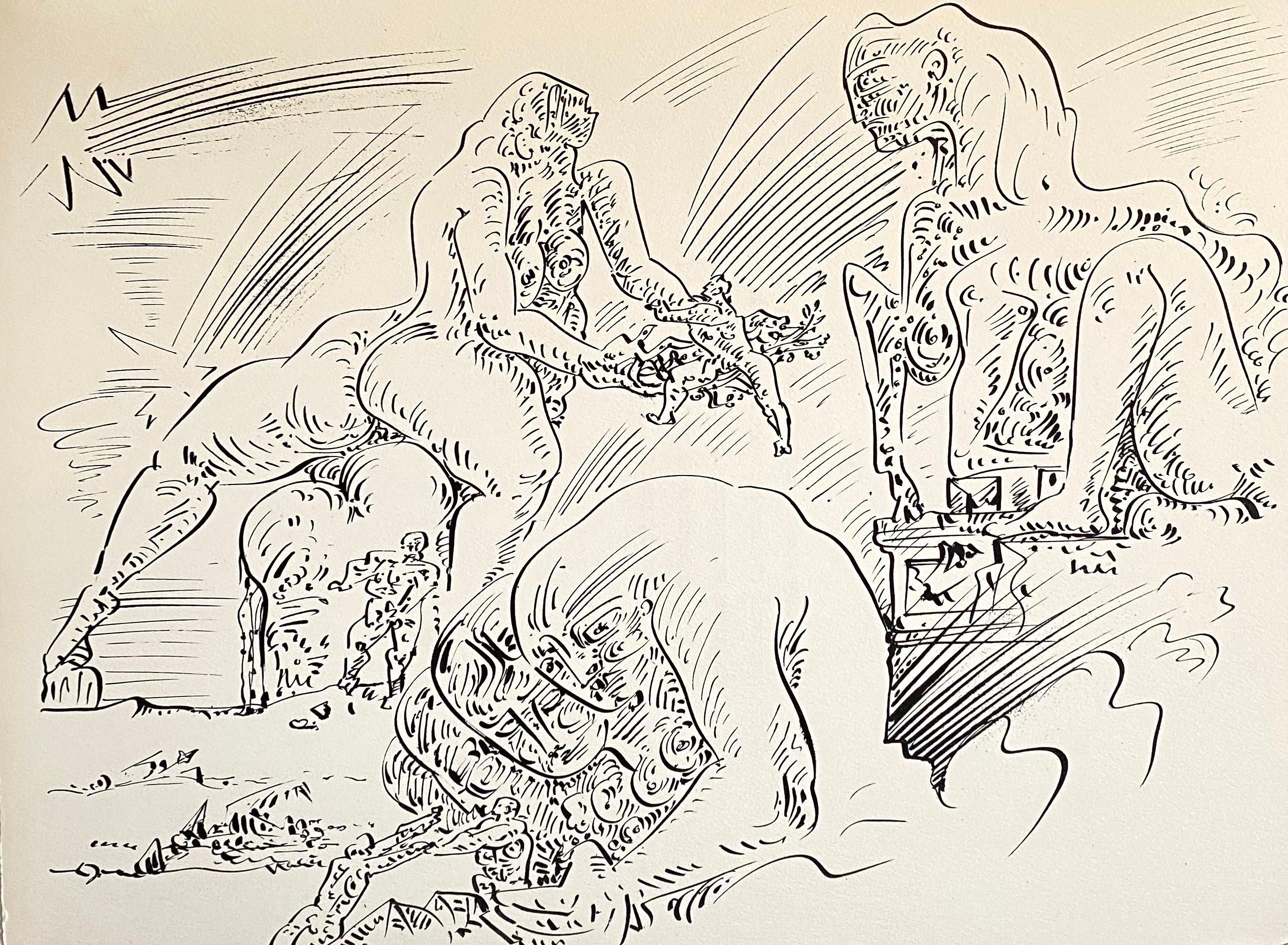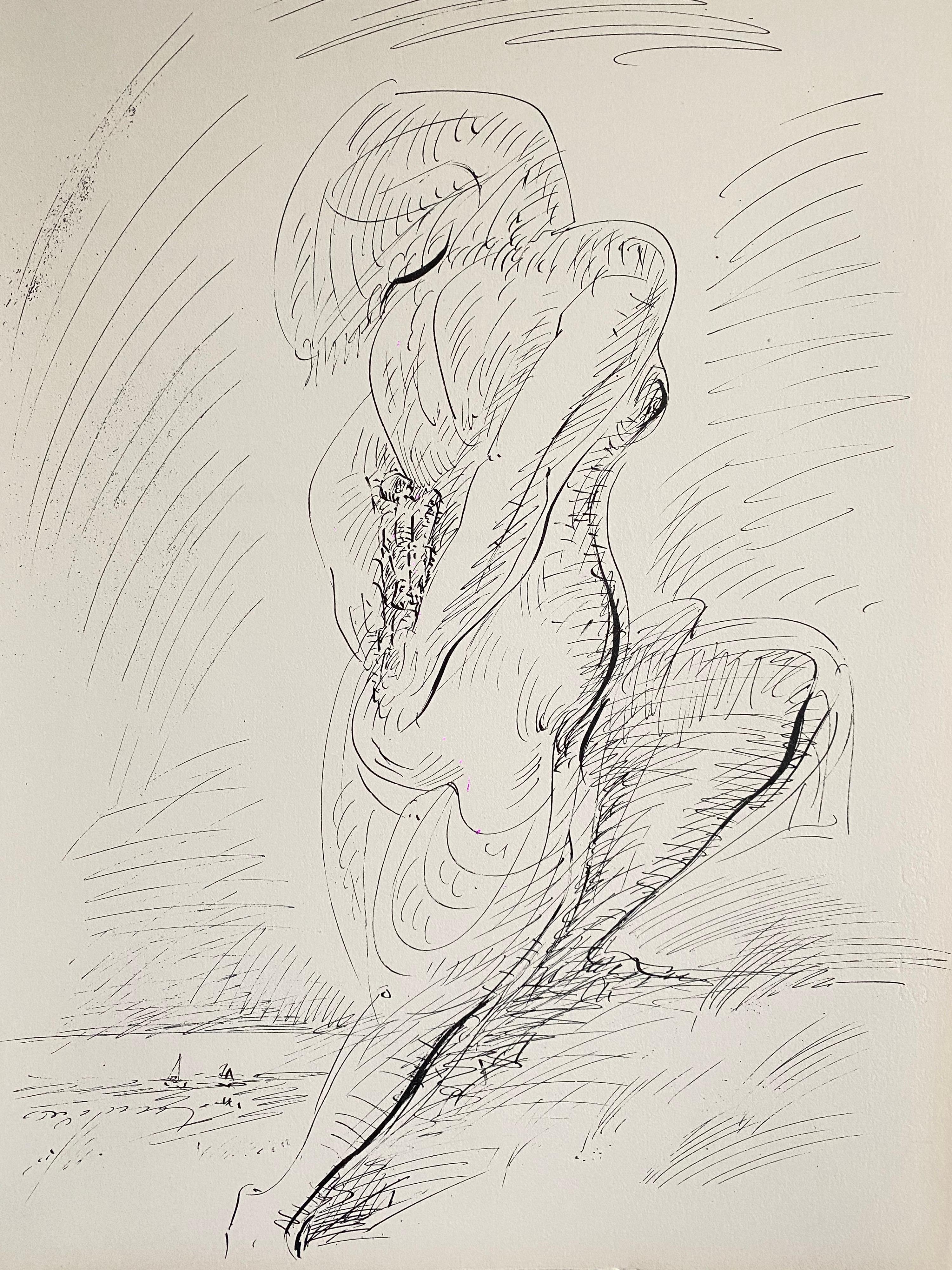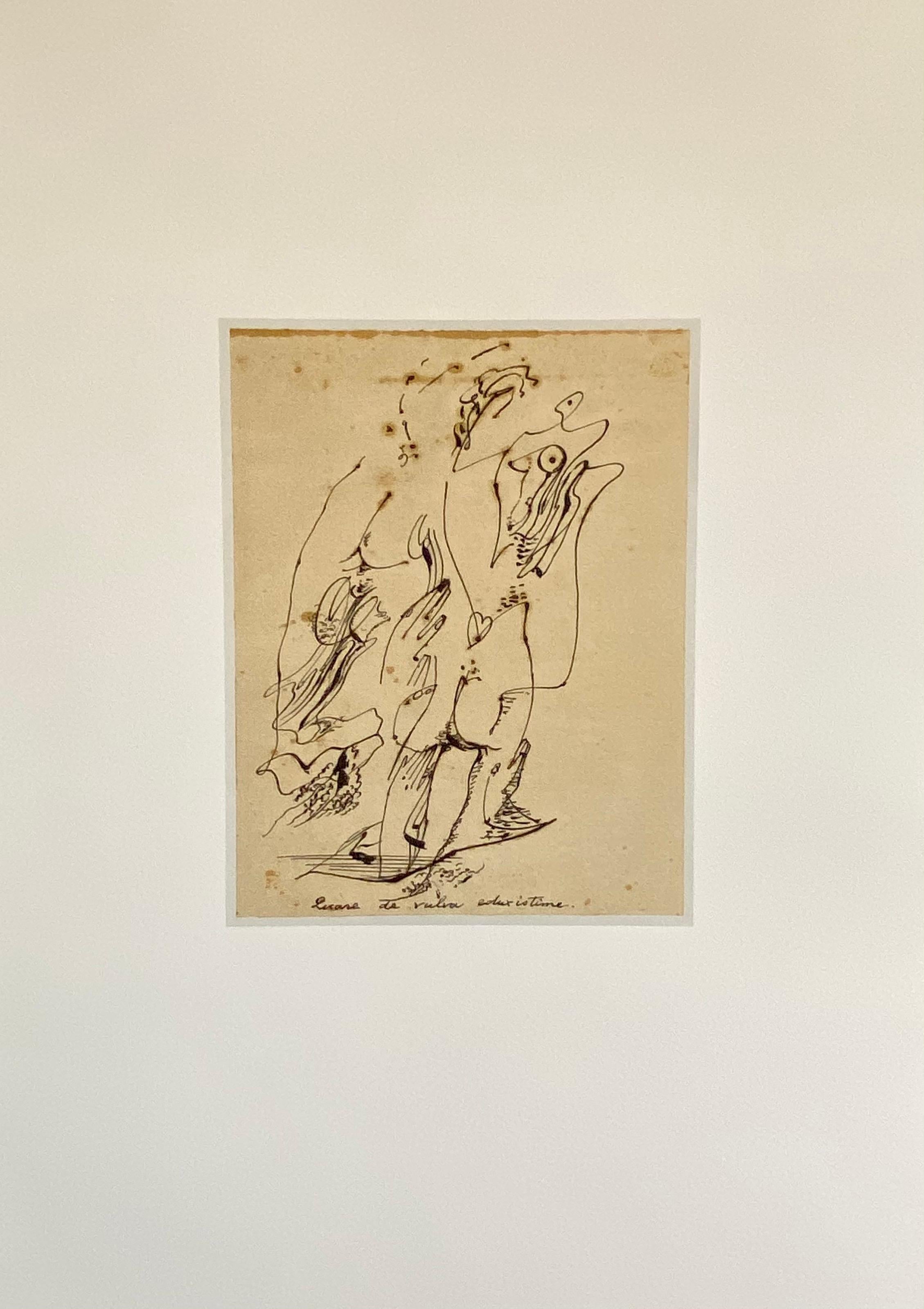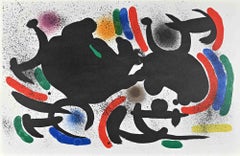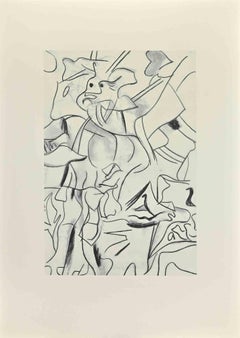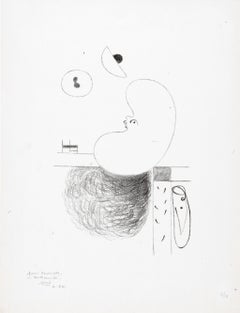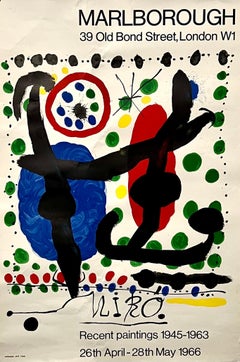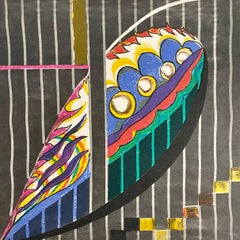
Mirò Lithographe I - Plate III
View Similar Items
Joan MiróMirò Lithographe I - Plate III1972
1972
About the Item
- Creator:Joan Miró (1893 - 1983, Catalan)
- Creation Year:1972
- Dimensions:Height: 13.39 in (34 cm)Width: 10.24 in (26 cm)
- Medium:
- Movement & Style:
- Period:
- Condition:
- Gallery Location:Roma, IT
- Reference Number:Seller: M-949241stDibs: LU65032777571
Joan Miró
With his wide-ranging oeuvre, comprising strikingly original paintings, prints, ceramics, sculptures, metal engravings and murals, Catalan modernist Joan Miró was a critical force in moving 20th-century art toward complete abstraction. Although often considered an early Surrealist because of his nonobjective imagery and evocation of the subconscious, he defies neat categorization.
Miró’s identity is largely rooted in the city of his birth: Barcelona. To this day, a number of his public artworks can be found there, including the 72-foot-tall statue Dona i Ocell (Woman and Bird), 1983. Female and avian forms, along with bright colors and the theme of Catalan pride, are recurring elements in his work.
The radical visual world Miró created with his expressive lines, signature symbols and biomorphic shapes influenced such American Abstract Expressionists as Jackson Pollock and Color Field painters like Mark Rothko and Barnett Newman.
Mirò continued to work and experiment until his death at the age of 90 in 1983. Five years before that, he was quoted saying, “I painted these paintings in a frenzy, with real violence so that people will know that I am alive, that I’m breathing, that I still have a few more places to go. I’m heading in new directions.”
Find a collection of original Joan Miró art on 1stDibs.
- Wunderhorn - Lithograph by Max Ernst - 1970sBy Max ErnstLocated in Roma, ITWunderhorn is an artwork realized by Max Ernst, Lewis Carrolls,1970. Lithograph on Japon Paper, igned and numbered 68/69. Printed and published by Manues Press (Embossing Stamp). ...Category
1970s Surrealist Abstract Prints
MaterialsLithograph
- Miró Lithographe I - Plate VII - Lithograph by Joan Mirò - 1972By Joan MiróLocated in Roma, IT"Miró Lithographe I - Plate VII" is a vintage lithograph realized by Joan Miró in 1972. Perfect conditions. It comes from the set of 11 lithographs realized for the catalogue "Mir...Category
1970s Surrealist Abstract Prints
MaterialsLithograph
- Woman - Offset and Lithograph - 1983By Willem de KooningLocated in Roma, ITWoman is an offset and lithograph print realized on Fabriano Paper after a drawing by Willem De Kooning of 1983. The print suite was realized in a limited edition of 2500, and curat...Category
1980s Surrealist Abstract Prints
MaterialsLithograph, Offset
- Untitled - Lithograph by Marcello Avenali - Mid-20th CenturyLocated in Roma, ITUntitled is a contemporary artwork realized by Marcello Avenali in the mid-20th Century. Mixed colored lithograph on paper. Includes frame: 38 x 3 x 43 cm Hand signed and numbered...Category
Mid-20th Century Surrealist Abstract Prints
MaterialsLithograph
- Composition - Lithograph by Jean-Pierre Jouffroy - 1963Located in Roma, ITComposition is an Original Lithograph realized by Jean-Pierre Jouffroy in 1963. Good condition on a yellowed paper. Signed, titled and dated by the a...Category
1930s Surrealist Abstract Prints
MaterialsLithograph
- Pour Ida Chagall et Franz Meyer - Lithograph by Joan Mirò - 1970sBy (after) Joan MiróLocated in Roma, ITPour Ida Chagall et Franz Meyer is a rare colored Lithograph realized in the 1970s by Joan Mirò (1893-1983). Signed in the plate on the lower right and inscribed pour Ida Chagall et...Category
1970s Surrealist Abstract Prints
MaterialsLithograph
$3,124 Sale Price20% Off
- L'Arbre des voyageurs: III - Joan Miró, Lithograph, SurrealistBy Joan MiróLocated in London, GBFrom Tristan Tzara's 'L'Arbre des voyageurs'. Signed and dated in pencil, a large paper proof. Inscribed 'Pour Henriette, en toute amitié'. Printed on wove paper and published by E...Category
1930s Surrealist Abstract Prints
MaterialsLithograph
- Joan Miro Vintage Surrealist Lithograph Poster Adrien Maeght Marlborough GalleryBy Joan MiróLocated in Surfside, FLJoan Miro, Spanish (1893–1983) Vintage lithograph poster from Arte Paris for a Marlborough Gallery show in London, England Signed in the plate Rece...Category
1960s Surrealist Abstract Prints
MaterialsLithograph
- Feminist Surrealist French Abstract Colorful Lithograph Print Myriam Bat YosefLocated in Surfside, FLMyriam Bat-Yosef Surrealist abstract lithograph print in colorful abstract shapes and shades Hand signed and dated 1971. sheet measures 9.25 X 9.25 inches ...Category
1970s Surrealist Abstract Prints
MaterialsLithograph
- Feminist Surrealist French Abstract Colorful Lithograph Print Myriam Bat YosefLocated in Surfside, FLMyriam Bat-Yosef Surrealist abstract lithograph print in colorful abstract shapes and shades Hand signed and dated 1971. sheet measures 9.25 X 9.25 inches The envelope and the Peter Buch poster is just for provenance and is not included in this sale. Myriam Bat-Yosef, whose real name is Marion Hellerman, born on January 31, 1931 in Berlin, Germany to a Jewish family from Lithuania, she is an Israeli-Icelandic artist who paints on papers, paintings, fabrics, objects and human beings for performances. Myriam Bat-Yosef currently lives and works in Paris. In 1933, her family fleeing the Nazi Holocaust, Miriam Bat-Yosef emigrates to Palestine and settles in Jaffa. In 1936, she suffers a family tragedy, her father, militant Zionist, is called to fight, still recovering from an operation of appendicitis. The incision will become infected, antibiotics did not exist yet, and her father will die in the hospital after 9 months of suffering. Myriam and her mother leave Palestine to live in Paris for three years. French is Myriam's first school language. In 1939, still fleeing Nazism, she returned to Palestine, leaving France by the last boat from Marseille. She moved to Tel Aviv with her mother, aunt and maternal grandmother. In 1940, she began attending the Academy of Fine Arts in Tel Aviv and took her name as an artist, Bat-Yosef, which means Joseph's daughter in Hebrew, as a tribute to her father. In 1946, Myriam graduated as a kindergarten teacher but wanted to be an artist. Her mother enrolled her in an evening school to prepare a diploma of art teacher. At 19, she performs two years of military service in Israel. In 1952, with a pension of $50 a month that her mother allocated, she went to study at the Beaux-Arts in Paris. To survive, she has several activities while studying. In 1955, she had her first solo exhibition, at the Israeli Club on Wagram Avenue in Paris. Many artists, such as Yaacov Agam, Yehuda Neiman Avigdor Arikha, Raffi Kaiser, Dani Karavan and sculptors Achiam and Shlomo Selinger attended the opening . In 1956, she enrolled at the School of Fine Arts in Florence. This is where she meets the painter Errô. They share an icy studio in winter. Myriam moves to Milan with friends. She organizes a joint exhibition with Erro, one room each, at the Montenapoleone gallery. Her works are admired by the sculptor Marino Marini and the painters Renato Birolli and Enrico Prampolini. Myriam and Erro exhibit in Rome, Milan, Florence and meet many personalities: Alain Jouffroy and his wife, the painter Manina, Roberto Matta and his wife Malitte, textile artist who was one of the founders of the Pompidou Center. Back in Paris, Myriam and Erro get married, which allows Myriam to avoid being called into the Israeli army during the Suez Canal War. In 1957, Myriam and her husband went to Iceland. Myriam works in a chocolate factory. Having enough money, she starts producing art again. She exhibited in Reykjavik's first art gallery. She meets the artist Sigridur Bjornsdottir, married to the Swiss painter Dieter Roth . In 1958, Myriam and her husband leave for Israel. They exhibit in Germany, then in Israel. Back in Paris, the couple became friends with artists of the surrealist movement, such as Victor Brauner, Hans Bellmer, the sculptor Philippe Hiquily, Liliane Lijn, future wife of Takis and photographer Nathalie Waag. Erro and Myriam have a daughter on March 15, 1960, named Tura, after the painter Cosmè Tura, but also close to the Icelandic Thora or the Hebrew Torah. Bat-Yosef’s complex trajectory throughout the 20th century is linked as much to the transnational history of what was for a time called the School of Paris as it is to a certain legacy of Surrealism. Her work features the same idea of resolving antinomies that also defined the spirit of surrealism, and is enhanced with her readings of the Kabbalah and her spiritual grounding in Taoism. However, while there are reasons for her approach to be associated with the process of the ready-made, it is important to consider the immediate intrication of these works with her practice of performance, during which the body itself is also painted – a feminist response to Yves Klein’s Anthropometries (1960) and an echo of the happenings which Jean-Jacques Lebel organised at the time in Paris. In 1963, Erró told Myriam that if she wants to be a painter, she can not be his wife. Myriam chose to be a painter and the couple divorced in 1964. Since that time, Myriam Bat-Yosef has exhibited in many countries: Europe, United States, Japan, etc. Although long in the shadows, the work of Myriam Bat-Yosef has been greeted by many artists and personalities: Anaïs Nin, Nancy Huston, André Pieyre of Mandiargues, José Pierre, René de Solier , Jacques Lacarrière, Alain Bosquet, Pierre Restany, Sarane Alexandrian and Surrealist André Breton who, after a visit to her studio, confided to having been intrigued by its phantasmagorical dimension. She was included in the book Pop Art and Beyond: Gender, Race, and Class in the Global Sixties by Mona Hadler and Kalliopi Minioudaki. Extract "World Citizen, Artist of the Pop Era Sarah Wilson; Why do we know so little of Myriam Bat-Yosef, the most important female Israeli artist of the Pop era? Issues of identity and sexuality feature constantly in her work. She exhibited internationally from Reykjavik to Tokyo; she had two shows at Arturo Schwarz’s famous Dada/surrealist gallery in Milan; she participated in feminist art events in Los Angeles. Above all, in 1971, she conceived Total Art, a Pop Gesamtkunstwerk inside and outside the Israel Museum, Jerusalem. Painter, performer, and installation artist, she was also a lover, wife, and mother. Of Lithuanian-Jewish descent, she was close to the family of philosopher Emmanuel Levinas. An émigré in Paris she would repudiate a national passport, participating in Garry Davis’s short-lived “World Citizens” movement. She continues the lineage of women surrealist artists: Valentine Hugo, Leonor Fini, Dorothea Tanning, Leonora Carrington, Unica Zürn, Jane Graverol, Toyen, Alice Rahon...Category
1970s Surrealist Abstract Prints
MaterialsLithograph
- Feminist Surrealist French Abstract Colorful Lithograph Print Myriam Bat YosefLocated in Surfside, FLMyriam Bat-Yosef Surrealist abstract lithograph print in colorful abstract shapes and shades Hand signed and dated 1971. sheet measures 9.25 X 9.25 inches ...Category
1970s Surrealist Abstract Prints
MaterialsLithograph
- Lithograph Belgian American Surrealism WPA Modernist Karl Fortess Surrealist ArtLocated in Surfside, FLKarl Eugene Fortess (1907-1993) Original color lithographs on BFK Rives paper, 1966, Hand signed and numbered 29/36 in pencil, Sheet size 20.5 x 15 inches. Karl E. Fortess (1907-1993) was a painter, printmaker and teacher, of Boston, Massachusetts and Woodstock, N.Y. Fortess was born in Antwerp, Belgium on October 13, 1907, and became an American citizen in 1923. He studied at the Art Institute of Chicago, the Art Students League in New York, and the Woodstock School of Painting with Yasuo Kuniyoshi. In 1937 the Works Progress Administration sent him and several other artists to Alaska to document the towns, villages, and remote wilderness landscapes (Pemberton, “Alaska art museum collects WPA’s Depression works from the territory,” Columbia Daily Tribune, November 9, 2003). Trains, trucks, and industrial buildings were what Karl Fortess envisioned when the Public Works of Art Project suggested that he depict “the American Scene.” His work bears the influence of Surrealism, Russsian Constructivist art and Cubism. He was part of a circle of left leaning artists loosley involved with the WPA which included Sol Wilson, Isaac Soyer, Louis Lozowick, Abraham Harriton, Ben Shahn, William Gropper, Nahum Tschacbasov, Morris Shulman, Yasuo Kuniyoshi, Louis Slobodkin, Adolf Dehn, Le Corbusier and Louis Schanker. Karl Fortress taught at the Art Students League, Brooklyn Museum Art School, Louisiana State University, Fort Wright College, and Boston University School of Fine and Applied Arts. He was a member of the Artists Equity Association, Society of American Graphic Artists, American Association of University Professors, and the British Film Institute. He was awarded the Guggenheim Fellowship in 1946, was named an Associate of the National Academy of Design in 1960 and elected to full Academician in 1971. Fortess taught at many different schools, including Boston University School of Fine Art, where he also created an archive of interviews with more than two hundred and fifty contemporary American painters, sculptors, and graphic artists including many with with artists associated with the Woodstock, N.Y. art community. Among the interviewees are Kenneth Armitage, Will Barnet, Romare Bearden, George Biddle, James Brooks, Adolph Dehn, Jane Freilicher, Julian Levi, Alice Neel, Larry Rivers, Moses Soyer, Dorothy Varian...Category
Mid-20th Century Surrealist Landscape Prints
MaterialsLithograph
